Are you searching for a display that is simple, effective, and visually appealing? Standard monochrome LCD modules are functional but lack the vibrance to make your product truly stand out.
A color alphanumeric character LCD is a type of display designed to show letters, numbers, and symbols in a fixed grid. It uses an color backlight to produce a range of colors, blending simplicity with visual appeal.
In my 13 years of experience in the LCD industry, I’ve seen these versatile displays provide the perfect, cost-effective solution for many projects. They offer a significant upgrade from monochrome without the complexity of a full graphic display.
What is the Definition and Core Understanding of these Displays?
Let’s begin with the fundamentals. Understanding what these displays are—and what they are not—is the first step to deciding if they are right for your product.
Essentially, a color alphanumeric LCD is a liquid crystal display engineered to show pre-defined characters in a set layout, such as 16 characters on 2 lines, with the added capability of a colorful backlight(Embedded Development Basic Tutorial: Detailed Explanation of the 16×2 LCD Module).
Basic Definition and Function?
At its core, a character LCD is a display device that uses liquid crystal technology to present textual information in a clear and efficient format. The “color” aspect typically comes from a multi-color backlight, most often an white/yellow-green/blue/red/orange/amber LED kits. The display itself is composed of several layers: two polarizers, glass substrates, and a layer of liquid crystals. When an electric voltage is applied, the crystals align themselves to either block or pass light from the backlight, forming the characters on the screen. The main function is to communicate information like status updates, menu options, or data readings in a simple, text-based format(What Is RGBW Backlight and How Does It Improve LCD Screens?).
How Does Alphanumeric Differ from Other Display Types?
It’s easy to get confused between the different types of simple displays. I often explain the differences to clients, they need to choose the right component for his products. The choice depends entirely on the application’s needs.
Here is a simple breakdown:
| Display Type | Key Characteristic | Best For |
|---|---|---|
| Character LCD | Displays text and symbols in a fixed grid (e.g., 16×2). | Menus, status readouts, and simple user interfaces. |
| Graphic LCD | Full pixel control, can display any image or custom font. | GUIs, charts, and complex visual information. |
| Segment LCD | Displays pre-defined shapes and numbers (like a calculator). | Displaying fixed numeric data with very low power use. |
For many applications, a character LCD hits the sweet spot between functionality and ease of use, which is why it remains so popular.
What Are Alphanumeric Characters?
The term “alphanumeric” is fundamental here. It precisely defines what these displays are designed to show and is key to understanding their capabilities and limitations.
Alphanumeric characters are a set of characters that include the 26 letters of the English alphabet (A-Z), the 10 Arabic numerals (0-9), and a collection of common punctuation marks and symbols.
What is Alphanumeric Characters Definition?
The term is a combination of “alphabetic” and “numeric.” In the context of an LCD, these characters are pre-programmed into a character generator (CG-ROM) on the display’s controller chip, like the famous Hitachi HD44780. When your microcontroller sends a command (for example, the ASCII code for “A”), the LCD controller looks up the corresponding 5×8 dot pattern in its memory and displays it in the specified location on the grid(Are all common character LCD modules based on the Hitachi HD44780 controller?).
What is Alpha Numeric Character Examples?
The standard character set is quite comprehensive for most applications. However, a key feature that we at Hua Xian Jing often help clients with is creating custom characters. Most controllers allow you to define a few of your own 5×8 pixel characters, which is perfect for simple icons like battery status, signal strength, or even small brand logos(How Can You Create Custom Characters on an Character LCD?).
Here are examples of the standard characters you can expect:
| Category | Examples |
|---|---|
| Uppercase Letters | A, B, C, … Z |
| Lowercase Letters | a, b, c, … z |
| Numbers | 0, 1, 2, … 9 |
| Punctuation | . , ; : ! ? |
| Symbols | @ # $ % & * ( ) |
What is the Technology Behind Color Alphanumeric LCDs?
The magic isn’t just in the characters; it’s in the technology that brings them to life with color. Understanding how this works helps you select the right display for your product’s needs.
These displays combine standard monochrome LCD technology with a color backlight. The color is generated not by the pixels themselves, but by the color LEDs of the backlight.
What is LCD Display Technology Fundamentals?
All LCDs work on a simple principle: liquid crystals can control the passage of light. In a character LCD, the liquid crystals are sandwiched between two polarizing filters. Without an electric field, light from the backlight passes through. When a voltage is applied to a specific segment (a pixel), the crystals twist, blocking the light and creating a dark dot on the screen. Combining these dots forms the characters(What Are the Key Differences Between TN, STN, and HTN LCD Technologies?).
What Color Technologies Are Available?
For character LCDs, the primary method for achieving color is through the backlight.
Alphanumeric LCD modules come with a fixed color backlight, like blue or white. These are less flexible but can be slightly more cost-effective if you only need one color.
How is Color Generated in Alphanumeric Displays?
The color generation is elegantly simple. The LCD layer itself remains monochrome—it just creates dark pixels on a background. It’s the background that becomes colored by the RGB backlight. This is an incredibly useful feature.
What are the Standard Configurations and Specifications?
When you start sourcing these displays, you will quickly notice a set of standard sizes and pinouts. Knowing these common configurations makes the selection and integration process much faster(How Do Rise and Fall Times of the Enable Pin Affect Data and Display Quality in LCD1602 Modules?).
The most popular configuration is the 16×2, meaning 16 characters per line and 2 lines. Other common sizes include 20×4, 16×1, and 40×2. Most of these modules use a standard 16-pin interface for connectivity.
What is 16x2 LCD Display Configuration?
The 16×2 is the workhorse of the character LCD world. It offers enough screen real estate for two lines of information, making it perfect for displaying menu items, sensor data, or status messages. Its compact size and low cost have made it a staple in the hobbyist community and in countless commercial products, from 3D printers to network-attached storage devices.
What Other Standard Sizes Exist?
While the 16×2 is most common, we manufacture a wide range of sizes at our factories to meet different product requirements. The choice depends on how much information you need to display at once.
| Size | Typical Application |
|---|---|
| 8×2 | Compact status indicators |
| 16×1 | Simple device readouts, single-line messages |
| 20×2 | Slightly more information than a 16×2 |
| 20×4 | Industrial controls, data logging, complex menus |
| 40×2 | Rack-mount equipment, larger user interfaces |
What is 16 Pin LCD Interface?
Most character LCDs use a de facto standard 16-pin interface. Understanding this pinout is the first step to connecting the display to your microcontroller.
- Power Pins (VSS, VDD): Ground and 5V/3.3V power supply.
- Contrast Pin (V0): Adjusts the character contrast.
- Control Pins (RS, R/W, E): These pins manage communication, telling the LCD whether you’re sending a command or data to be displayed.
- • Data Pins (D0-D7): These are the 8 pins that carry the actual data for the characters.
- • Backlight Pins (A, K): Anode and Cathode for powering the LED backlight.
What Interface Types and Connectivity Options Are There?
Getting your display to communicate with your microcontroller is a critical step. Fortunately, you have a few well-established options, each with its own advantages and disadvantages.
The two primary interface methods are parallel and serial (most commonly I2C). A parallel interface is faster but requires many I/O pins, while I2C is slower but greatly simplifies wiring by using just two data lines(What Are the Differences Between SPI and I2C for LCD Modules?).
What is Parallel Interface Implementation?
This is the classic way to control a character LCD, connecting the microcontroller’s pins directly to the display’s 16-pin header. You have two modes(What is the difference between using an LCD in 4-bit mode versus 8-bit mode when interfacing?):
- 8-bit mode: Uses all 8 data pins (D0-D7). It’s the fastest way to send data.
- 4-bit mode: Uses only 4 data pins (D4-D7). It’s slightly slower as it sends data in two halves, but it saves 4 precious I/O pins on your microcontroller.
What is I2C LCD Display Integration?
For projects where I/O pins are limited, an I2C interface is the perfect solution. This is achieved using a small “backpack” adapter board that is soldered onto the LCD’s 16 pins. This backpack contains an I/O expander chip (like the PCF8574) that acts as a translator. It receives commands over the simple two-wire I2C bus (SDA and SCL) and converts them into the parallel signals the LCD understands. This is a very common choice for Arduino and Raspberry Pi projects(How Does I2C for LCD Communication Work?).
What Programming Methods Are Available?
One of the biggest advantages of character LCDs is their programming simplicity. Because they have been around for so long, there are mature, stable, and well-documented libraries for nearly every development platform imaginable.
- For Arduino: The
LiquidCrystal.hlibrary is built-in for parallel control, and theLiquidCrystal_I2C.hlibrary is the standard for I2C. - The basic programming flow is always the same:
- Initialize the display in your setup code.
- Use a command to set the cursor to the desired position (e.g., line 1, character 3).
- Send the text or character data you want to display.
What are the Main Applications and Use Cases?
From the coffee machine in your kitchen to the complex machinery on a factory floor, these displays are everywhere. Their versatility makes them a go-to choice across many different industries(How Are Embedded LCDs Used in Human-Machine Interfaces (HMIs) for Industrial Control Systems?).
They are widely used in consumer electronics, industrial control panels, medical devices, vending machines, and educational kits. Their popularity stems from their low cost, excellent readability, and simple implementation.
What Consumer Applications Benefit?
In consumer goods, character LCDs provide a simple and effective user interface. You can find them in:
- 3D printers and CNC machines
- Network routers and modems
- Smart home hubs and thermostats
- Kitchen appliances like microwaves and coffee makers
- DIY electronics projects
What Industrial Applications Require These Displays?
In the industrial sector, reliability and clarity are paramount. The ability to use color for status indication is a huge benefit. Common applications include:
- Factory automation controllers (PLCs)
- Test and measurement equipment
- Power supply units
- Pump and motor controllers
What Educational and Hobbyist Projects Use Them?
This is where the character LCD truly shines. The 16×2 LCD is a rite of passage for anyone learning electronics. It’s included in nearly every Arduino starter kit because it’s a fantastic tool for teaching the fundamentals of hardware interfacing and programming in a way that provides immediate, tangible results.
What Are the Key Advantages and Benefits?
Why would you choose a color character LCD over a modern, high-resolution OLED or TFT display? The answer lies in a powerful combination of simplicity, cost, and proven reliability.
Their main advantages are very low cost, ease of programming with extensive library support, low power consumption compared to graphic displays, and excellent long-term reliability and operational lifespan.
What Programming Advantages Do They Offer?
From a developer’s perspective, these displays are a dream to work with.
- Simple Command Set: The commands for clearing the screen, setting the cursor position, and writing characters are simple and universal.
- Mature Libraries: You don’t need to write low-level code. Well-tested libraries handle all the hard work.
- Low Memory Usage: Unlike graphic displays, character LCDs don’t require a large frame buffer in your microcontroller’s RAM, which is a huge benefit for smaller, cost-effective MCUs.
What Cost Benefits Are Available?
This is often the deciding factor for our B2B clients. Character LCDs are one of the most affordable display technologies on the market. As a manufacturer with 3 factories and 28 production lines, we at Hua Xian Jing can produce these modules in extremely high volumes. This economy of scale drives the unit cost down significantly, making them ideal for cost-sensitive products.
What Reliability Features Exist?
These displays are built to last.
- Long Lifespan: The LCD itself has a very long operational life. The backlight LEDs are typically rated for 50,000 to 100,000 hours of use(What Is the Typical MTBF for Commercial LCD Modules?).
- Robust Construction: They are mechanically simple and resistant to moderate shock and vibration(How Do LCD Modules Withstand Salt-Fog Environments?).
- Wide Temperature Range: We can supply modules with extended operating temperature ranges (e.g., -20°C to +70°C), which is a critical requirement for products used outdoors or in industrial environments(The Effect of Temperature on the Functional Performance of LCD Modules).
What Technical Specifications and Performance Metrics Matter?
When you start comparing datasheets, certain numbers and specifications are more important than others. Understanding these ensures the display will perform correctly in your specific application.
Key specifications to check are the display’s viewing angle, contrast ratio, operating temperature range, and power consumption. These technical details directly impact the display’s real-world readability and durability.
What Viewing Characteristics Matter?
Readability is crucial, and it’s determined by two main factors:
- Viewing Angle: Datasheets will specify a viewing direction, often as “6 o’clock” or “12 o’clock.” This indicates the optimal angle for viewing the display. A 6 o’clock display is best viewed from below, making it ideal for desktop devices. A 12 o’clock display is best viewed from above, suitable for rack-mounted equipment(How does viewing angle relate to LCD backlight design?).
- Contrast Ratio: This is the difference in brightness between the illuminated background and the dark pixels. A higher contrast ratio means the characters will be sharper and easier to read(Why Do Some LCD Modules Require a Negative Voltage for Contrast Adjustment?).
What Power Requirements Apply?
Character LCDs are known for their low power consumption.
- Logic Voltage: Most modules run on either 5V or 3.3V logic levels, making them compatible with most microcontrollers(What Is the Right Way to Use Level Shifters With 3.3V LCD Modules in 5V Systems?).
- Backlight Current: The backlight is the most power-hungry component. A typical RGB backlight might draw 20-60mA, but this current can be controlled with resistors or a PWM signal to adjust brightness and manage power draw.
What Environmental Factors Affect Performance?
A display’s environment can significantly impact its performance and lifespan.
- Temperature: Extreme cold can cause the liquid crystals to respond slowly, making the display appear sluggish. Extreme heat can permanently damage the display. Always choose a module rated for your product’s expected operating temperature range.
- UV Exposure: If the display will be used in direct sunlight, a UV-resistant filter is essential to prevent the polarizers from degrading over time.
What are the Selection Criteria and Design Considerations?
Finally, choosing the right display involves more than just reading a datasheet. You need to consider how it fits into your product’s overall design, function, budget, and supply chain.
The most important selection criteria are the physical size and format, the required color and backlight features, and the interface type (parallel or I2C) that best matches your system’s hardware resources.
What Size and Format Factors Matter?
Before you commit, check the module’s mechanical drawing in the datasheet. Look at the overall dimensions, the mounting hole locations, and the character size. Will it fit in your enclosure? Is the text large enough to be read from the intended viewing distance? These practical considerations are just as important as the electronic specifications.
What Color and Backlight Options Exist?
While a full RGB backlight offers the most flexibility, ask yourself if you really need it. If your product only needs to indicate “”on”” (green) and “”fault”” (red), you might not need the full spectrum. As an OEM/ODM provider, we can customize the backlight to a client’s exact specifications. We can fine-tune the color mix to match a specific brand color or optimize the brightness for a particular environment, which adds a professional touch to the final product.
What Interface Requirements Should You Consider?
This is a critical design trade-off I frequently discuss with clients. The choice between parallel and I2C comes down to your system’s resources.
- Choose Parallel if: Speed is critical and you have plenty of available I/O pins on your microcontroller.
- Choose I2C if: You need to conserve I/O pins for other components, or if you want to simplify the wiring and PCB layout.
Conclusion
Color alphanumeric LCDs are a simple, reliable, and highly cost-effective way to add a vibrant and informative display to your product. They are a powerful and proven tool for any hardware designer.
Related Articles:
How to Design Your Own Segment LCD?
What Special Requirements Do Medical LCD Panels Have?
How Does SPI Enable Reliable Communication with LCD Modules?
How Does Baud Rate Affect Monochrome LCD Data Transmission?
How Do You Integrate a Graphical LCD with an RTOS Task Scheduler?
FAQ
Can I use a color alphanumeric LCD outdoors?
Most modules support sunlight readability with proper backlight, but check brightness specs for your application.
How difficult is it to customize the color options?
Custom backlight colors or filter options are available for large orders; small changes are easy with ODM suppliers like us.
Do these displays work with Arduino and Raspberry Pi?
Yes, most color alphanumeric LCDs have compatible libraries for Arduino and Raspberry Pi platforms.
What if I need to display simple graphics?
Alphanumeric LCDs focus on text; for simple graphics, choose dot-matrix or graphic LCD modules instead.
Are color alphanumeric LCDs affected by vibration or shock?
They are robust for most environments, but for extreme industrial use, ask your supplier about ruggedized versions.










